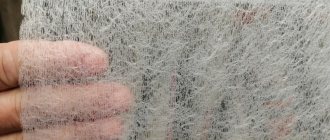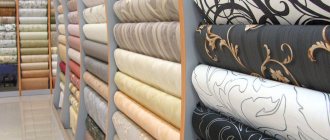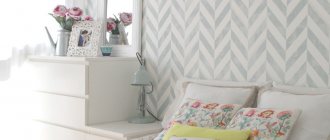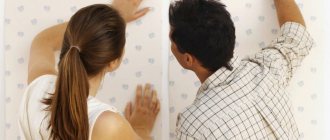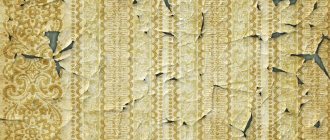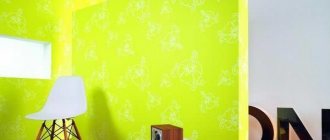Paintable wallpaper for the ceiling - as easy as shelling pears
Often, wallpaper is chosen as the basis for the design of the ceiling, since it can imitate various types of finishing materials, including stone, marble, wood, and have a textured pattern. But simply covering the surface with them is not enough: they still need to be painted, only then will they look interesting and decorate the interior (see How to decorate a ceiling with your own hands: options for ideas). The photo shows what effect painting wallpaper on the ceiling can create.
How to choose wallpaper
Wallpapering the ceiling for painting is becoming increasingly popular. This finish looks beautiful and will last for many years, because the coating can be washed. In addition, this material hides minor surface defects.
Buyers have the opportunity to buy two types of ceiling wallpaper for painting: paper and non-woven. The latter are more reliable and have a long service life; they can be washed. There are domestic and imported wallpapers, the latter is better - they can be repainted several times (about
Tips for high-quality wallpapering
To achieve high-quality gluing, you should familiarize yourself with a number of useful tips:
- The gluing process should begin in the direction away from the window.
- To do this work by one person without assistants, for convenience you need to fold the wallpaper like an accordion and gradually straighten it during the gluing process. But without some experience it will be difficult to cope with such work.
- It is better to glue the canvases along the length of the room. But they are also glued across, for example, if a print with stripes is chosen, such wallpaper glued across the width of the room can visually make it larger.
- Using wide meter-long sheets saves finishing time, but the process itself is more labor-intensive and energy-intensive.
- To design rounded corners, it is advisable to choose ceiling coverings with a harder and denser texture.
How to choose paint
The choice of paint depends, first of all, on the type of wallpaper used. Fiberglass can be painted with any composition, and for example, only water-dispersion paint is suitable for non-woven wallpaper. But even if you can choose any paint for coating, you should approach this responsibly, because the properties of the surface depend on the choice.
Alkyd enamels are often used to paint ceilings. They create a wear-resistant, hard and moisture-resistant film; such a surface can be cared for using detergents. But they also have many shortcomings. Before drying, the enamel releases toxic substances, and in addition, it smoothes the coating, and ceiling wallpaper is bought for painting to create a relief surface. It interferes with the air permeability of the ceiling, which leads to disruption of the microclimate of the room. Thus, painting wallpaper in residential areas with enamel is not the most reasonable solution.
As for water-dispersion paints, they contain acrylic and polymer additives, which create a wear-resistant coating and make it washable. If you need to give a certain shade, it is better to resort to machine tinting. It is difficult to accurately calculate the required amount of paint, even when its consumption per square meter of surface is known. If there is not enough composition, it will be impossible to create exactly the same tone, and the coating will differ in color. Machine tinting allows you to repeat the paint tone using the same code. When purchasing coloring pigments, you need to choose those that are suitable in composition.
Ceiling gluing technology
Here you will need certain tools and materials:
- the required amount of wallpaper;
- scissors;
- tape measure for measuring the required length of wallpaper;
- glue brush;
- ready-made glue;
- a soft, clean roller for smoothing pasted strips.
Wallpapering tools
When the work surface is ready, all materials are at hand, the glue is diluted, you can start gluing. If the wallpaper is paper-based, first apply glue to a strip of wallpaper, trying not to leave dry places, but you cannot apply too much glue. Paper wallpaper easily gets wet, deformed and even breaks, so you can’t overexpose it either. The ceiling is smeared with glue along the marked lines; it is not worth treating the entire surface at once, because it dries quickly. While you are applying glue to the ceiling, the wallpaper has already been saturated; now you need to apply it to the ceiling according to the markings and slightly pressing it, carefully leveling it with a soft roller.
If the wallpaper is non-woven or based on glass fibers, then there is no need to spread it with glue, just apply the glue to the ceiling. It is worth noting that it is much more difficult to glue ceiling wallpaper, and therefore it is almost impossible to do it alone. It is better to glue the wallpaper together, so the process will go faster and will be of better quality.
Ceiling wallpaper is laid joint-to-joint, and not overlapping, so along the edges the wallpaper is smeared with glue especially well and pressed harder. To make the appearance of the pasted ceiling more harmonious, it is recommended to use ceiling plinths. This is where the gluing ends and now the main thing is to isolate the room from drafts.
How to glue wallpaper to a ceiling for painting
It is not difficult to install special wallpaper for painting, since the principle of operation is similar to that in the case of ordinary wallpaper. Paper products are impregnated with glue before painting; non-woven wallpaper does not require this - the glue is applied to the ceiling itself (for more details: “How to glue non-woven wallpaper on the ceiling”). The pasted canvas is smoothed with a roller so that there are no air bubbles left between it and the surface. The process is shown in the video.
Features of coloring different types of wallpaper
Each type of wallpaper, after painting, acquires an individual coating. Thus, this parameter can become a decisive factor when choosing the required material.
Nuances:
- Paper wallpaper makes it possible to obtain a surface that will be visually uniform - there will be a complete impression of the absence of joints. But this type of canvas can cause some problems that appear after gluing. The fact is that the paper, when drying, can shrink unplanned.
- The non-woven version is much easier to glue, because there is no need to coat the material with glue, it is enough to treat the base. Coloring allows you to get a beautiful layer on which the existing texture will stand out.
- To use glass wallpaper, you must use special adhesives that are designed for such work. Craftsmen advise pre-treating the ceiling not with a simple primer, but with a latex one. The canvases are easy to paint, given that almost any composition is suitable for the job.
Canvases intended for painting are quite heavy, so special types of glue are produced for them
On a note! It is the last two options that are more preferable if it is necessary to create a relief surface.
Preparing for painting
To prevent accidents related to short circuits, etc., the electrical wiring in the room is de-energized. It is very important to bring the air temperature to the values recommended by the manufacturer. There should be no drafts, otherwise the paint will dry unevenly and thereby attract dust. Doors, floors, windows, lamps are covered with special material, and furniture is taken out. If the room is undergoing a complete renovation, then the ceiling is painted before finishing the walls, and when only the ceiling is being worked on, the walls are covered with plastic film.
After the necessary tools have been prepared (gloves, hat, safety glasses, roller, brushes, stepladder, paint tray), begin painting the ceiling. What the room should look like before renovation after preparing the ceiling for painting is shown in the photo.
Traditional painting method
Paper wallpaper and fiberglass are painted as follows. Using a brush, paint is applied to the ceiling along the perimeter and corners, and the rest of the surface is covered with a roller (read: “How to properly paint a ceiling with a roller: painting secrets”). Apply the composition in two layers: the first - perpendicular to the direction of light, the second - parallel to it. The first layer must be completely dry before applying the next one.
The paint is poured into a tray, a roller is dipped in it, which is rolled several times over the flat part so that the composition is distributed evenly and there is no excess. Thanks to this, it is possible to avoid splashes during application and reduce paint consumption. Then the composition is applied to the ceiling. You can watch a video of this process.
Design ideas and drawings
Thanks to patterns, designs and bold design ideas, the most ordinary ceiling surface acquires a multifaceted, interesting and voluminous appearance.
Sky
The surface of the sky evokes thoughts in a person and distracts him from everyday life and bustle. 3D wallpaper with a picture of the sky will bring air, freshness and serenity to the interior.
Frescoes
When choosing this design method, you need to take into account all the characteristics of the room. Such wallpaper will allow you to divide the room into a relaxation area and a workplace. Frescoes depicting landscapes are perfect for the ceiling in the living room, and fairy-tale pictures will decorate the interior of the nursery.
Glow in the dark stars
They will create an atmosphere of magic and mystery. Having accumulated daylight, fluorescent stars will give a pleasant glow at night, making you dream before bed.
The photo shows the interior of a bedroom decorated with wallpaper with glowing stars.
Space
When choosing space wallpaper, you should not use pictures with large objects, so as not to get the feeling of an enclosed space. Images of constellations and comets with the right lighting will create the impression of space flight.
Geometric figures
Geometry on the ceiling will allow you to achieve harmony in the decor of your home. Squares represent conciseness and restraint, helping to relax and unwind. Thanks to their orderliness, the effect of a calm interior is obtained.
The photo shows a living room with a ceiling lined with bright wallpaper with geometric patterns.
Under the tree
They perfectly imitate wood and harmonize perfectly with a vintage or rustic style room.
The photo shows a living room interior in a modern style and a ceiling covering that imitates wood.
Floral drawing
The quality of the ceiling coverings is very high, and the images are clear and realistic. All together this creates an amazing atmosphere of magnificent fresh flowers. A ceiling decorated with voluminous 3D photographic materials can give a charge of optimism for the whole day.
Mirror
They give a feeling of spaciousness, add light, visually raise the height of the room and create a rich and stylish appearance.
Gozhka
The canvases perfectly hide unevenness, small cracks and roughness. Ceiling wallpaper of this type is also used for painting. Due to their special textured weaving in the form of cells, when painted they become dense and give the ceiling a special volume.
Coloring non-woven wallpaper
Non-woven ceiling wallpaper for painting allows you to create a very interesting coating that will complement and decorate the interior.
Structural finishing materials are sometimes painted before gluing to the surface, applying latex paint on the reverse side. When the base of the wallpaper itself is painted, the front side remains white and stands out beautifully. After drying, the canvas is glued to the ceiling.
The surface will have a pastel shade if you paint not the wallpaper itself, but the ceiling, but you need to choose a very bright and saturated color. This way, the paint will shine through the material, and the shade will be muted.
The result will be excellent when painting non-woven wallpaper on the ceiling using the following method. For this purpose, dispersion paint is diluted more than usual, applied to the pasted canvases and washed with a clean cloth. After drying, the relief pattern is tinted with a contrasting color. Paintable wallpaper not only looks great, but also allows you to not worry about the condition of the ceiling for many years.
Advantages and disadvantages of finishing the ceiling with liquid wallpaper
The main advantage of liquid wallpaper is its magnificent appearance and the ability to create a variety of ceiling structures. Using liquid wallpaper, you can create a whole pattern on the ceiling using a mixture of different colors and textures.
- Another advantage is that this material breathes, as it has a natural composition.
- They allow air and moisture to pass through well, meaning liquid wallpaper can even be used on the kitchen ceiling without fear of mold.
- This wallpaper is also easy to use. They dry quickly and do not have an unpleasant odor. Plus, as mentioned above, they are safe.
The disadvantages of liquid wallpaper include their rather high price, and also the fact that, although they are still a new product on the market, they do not have such a wide variety of colors as other finishing materials. However, this drawback, of course, was eliminated over time.
Advantages of ceiling wallpaper
Paper ceiling wallpaper is considered one of the most budget-friendly finishing materials, even taking into account the most advanced innovative finishing techniques. Anyone can stick wallpaper on the ceiling. Although the task takes a lot of time and also requires a lot of effort, most still manage to apply the new finish with their own hands, without resorting to the help of specialists.
Repair work of any type is always scary because after finishing the room there is a lot of dust and debris left behind. Decorating ceilings with wallpaper allows you to avoid these unpleasant nuances. Cleaning after covering surfaces with trellises takes a minimum of time.
Correctly selected ceiling wallpaper in the interior looks appropriate and quite impressive. The trellis fabric does not reduce the height of the ceilings in the room, which is ideal for miniature rooms.
Depending on the type of source material and the quality of finishing, a laminated ceiling can look great from 5 to 15 years. In fact, no other type of finishing materials can please you with such an impressive service life.
A wide range of products of this profile allows you to make any interior transformations: glue a base and then paint wallpaper on the ceiling, create neutral compositions or decorate surfaces in an original way with an unusual pattern. You can use silk plaster, decorate with various auxiliary elements (from stucco molding to fluorescent stickers), and also perform many other interesting experiments.




